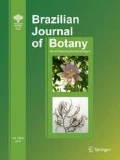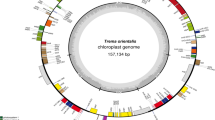Abstract
Prunus triloba var. plena, also known as flowering plum, is a perennial deciduous shrub admired for its brilliant pink-purple blooms. Chloroplast (cp) DNA is highly conserved in structure and gene arrangement, making cp genomic data valuable resources for species delimitation and phylogenetics. The cp genome of P. triloba var. plena was de novo assembled with the aim of developing cp-derived molecular markers and deepening the understanding of phylogenetic relationship among Prunus species. The complete cp genome was 158,022 bp in length, with a GC content of 36.8%. The plastome featured a typical quadripartite structure, consisting of a pair of inverted repeat (IR) regions of 26,379 bp, separated by a large single copy (LSC) region of 86,242 bp, and a small single copy (SSC) region of 19,022 bp. The cp genome encoded 134 genes, including 87 protein-coding genes, 39 tRNA genes, and 8 rRNA genes. A total of 59 simple sequence repeat (SSR) were identified, 68% of which were located in the intergenic regions. An obvious A/T bias was observed in the majority of SSRs detected. Besides, 48 repeats in different sizes and types were detected. These repeats, together with SSRs and the divergence hotspots detected, could serve as markers facilitating species discrimination and evolutionary research in Prunus. Using plastome sequences, we re-investigated the phylogenetic relationship among 32 Prunus species. These species explicitly clustered into three monophyletic clades, among which P. triloba var. plena was closely related to species in the subgenera Amygdalus and Prunus.






Similar content being viewed by others
References
Bankevich A et al (2012) SPAdes: a new genome assembly algorithm and its applications to single-cell sequencing. J Comput Biol 19:455–477. https://doi.org/10.1089/cmb.2012.0021
Bobik K, Burch-Smith TM (2015) Chloroplast signaling within, between and beyond cells. Front Plant Sci 6:781. https://doi.org/10.3389/fpls.2015.00781
Bolger A, Lohse M, Usadel B (2014) Trimmomatic: a flexible trimmer for Illumina sequence data. Bioinformatics 30:2114–2120. https://doi.org/10.1093/bioinformatics/btu170
Bortiri E et al (2001) Phylogeny and systematics of Prunus (Rosaceae) as determined by sequence analysis of ITS and the chloroplast trnL-trnF spacer DNA. Syst Bot 26:797–807. https://doi.org/10.1043/0363-6445-26.4.797
Cong X (1991) Studies of the reproduction of green branch cutting of Prunus triloba var. plena. Acta Hortic Sin 18:278–280
da Silva Oliveira EJ, Marques A, Almeida C (2019) The chloroplast genome of Hancornia speciosa Gomes: structural organization and phylogenomic studies in Rauvolfioideae (Apocynaceae). Braz J Bot 42:449–455. https://doi.org/10.1007/s40415-019-00549-8
Duan Y-Z, Shen Y-H, Kang F-R, Wang J-W (2019) Characterization of the complete chloroplast genomes of the endangered shrub species Prunus mongolica and Prunus pedunculata (Rosales: rosaceae). Conserv Genet Resour 11:249–252. https://doi.org/10.1007/s12686-017-0979-7
Duan C, Shen Y, Zhao G (2020) Complete chloroplast genome characteristics of Prunus triloba Lindl. Mitochondrial DNA B 5:504–505. https://doi.org/10.1080/23802359.2019.1704657
Gao K, Li J, Khan WU et al (2019) Comparative genomic and phylogenetic analyses of Populus section Leuce using complete chloroplast genome sequences. Tree Genet Genomes 15:32. https://doi.org/10.1007/s11295-019-1342-9
Gilman EF (1997) Trees for urban and suburban landscapes. Delmar, Albany
Greiner S, Lehwark P, Bock R (2019) OrganellarGenomeDRAW (OGDRAW) version 1.3.1: expanded toolkit for the graphical visualization of organellar genomes. Nucleic Acids Res 47:W59–W64. https://doi.org/10.1093/nar/gkz238
Haberle RC, Fourcade HM, Boore JL, Jansen RK (2008) Extensive rearrangements in the chloroplast genome of trachelium caeruleum are associated with repeats and tRNA genes. J Mol Evol 66:350–361. https://doi.org/10.1007/s00239-008-9086-4
Huang J, Yang X, Zhang C, Yin X, Liu S, Li X (2015) Development of chloroplast microsatellite markers and analysis of chloroplast diversity in Chinese jujube (Ziziphus jujuba Mill.) and wild jujube (Ziziphus acidojujuba Mill.). PloS One 10:e0134519. https://doi.org/10.1371/journal.pone.0134519
Kalkman C (1966) The old world species of Prunus subg. Laurocerasus including those formerly referred to Pygeum. Blumea Biodiv Evol Biogeogr Plants 13:1–115. https://doi.org/urn:nbn:nl:ui:19-526237
Katoh K, Standley DM (2013) MAFFT multiple sequence alignment software version 7: improvements in performance and usability. Mol Biol Evol 30:772–780. https://doi.org/10.1093/molbev/mst010
Kearse M, Moir R, Wilson A et al (2012) Geneious Basic: An integrated and extendable desktop software platform for the organization and analysis of sequence data. Bioinformatics 28:1647–1649. https://doi.org/10.1093/bioinformatics/bts199
Kim HT, Kim JS, Lee YM et al (2018) Molecular markers for phylogenetic applications derived from comparative plastome analysis of Prunus species: novel phylogenetic markers for Prunus species. J Syst Evol 57:15–22. https://doi.org/10.1111/jse.12453
Kocoń J, Muszyński S (1982) Ultrastructure of pollen grain sculpturing in several species of the Rosaceae family. Acta Soc Bot Pol 51:341–344. https://doi.org/10.5586/asbp.1982.030
Krawczyk K, Nobis M, Myszczyński K, Klichowska E, Sawicki J (2018) Plastid super-barcodes as a tool for species discrimination in feather grasses (Poaceae: Stipa). Sci Rep 8:1924. https://doi.org/10.1038/s41598-018-20399-w
Kumar S, Stecher G, Li M, Knyaz C, Tamura K (2018) MEGA X: molecular evolutionary genetics analysis across computing platforms. Mol Biol Evol 35:1547–1549. https://doi.org/10.1093/molbev/msy096
Kurtz S, Choudhuri JV, Ohlebusch E, Schleiermacher C, Stoye J, Giegerich R (2001) REPuter: the manifold applications of repeat analysis on a genomic scale. Nucl Acids Res 29:4633–4642. https://doi.org/10.1093/nar/29.22.4633
Lee S, Wen J (2001) A phylogenetic analysis of Prunus and the Amygdaloideae (Rosaceae) using ITS sequences of nuclear ribosomal DNA. Am J Bot 88:150–160. https://doi.org/10.2307/2657135
Lee SR, Kim K, Lee BY, Lim CE (2019) Complete chloroplast genomes of all six Hosta species occurring in Korea: molecular structures, comparative, and phylogenetic analyses. BMC Genom 20:833. https://doi.org/10.1186/s12864-019-6215-y
Li B, Huang P, Guo W, Zheng Y (2020) Development of nuclear SSR and chloroplast genome markers in diverse Liriodendron chinense germplasm based on low-coverage whole genome sequencing. Biol Res 53:21. https://doi.org/10.1186/s40659-020-00289-0
Liu X, Chang EM, Liu J et al (2019) Complete chloroplast genome sequence and phylogenetic analysis of Quercus bawanglingensis Huang, Li et Xing, a vulnerable oak tree in China. Forests 10:587. https://doi.org/10.3390/f10070587
Mayor C, Brudno M, Schwartz JR et al (2000) VISTA : visualizing global DNA sequence alignments of arbitrary length. Bioinformatics 16:1046–1047. https://doi.org/10.1093/bioinformatics/16.11.1046
McKain M, Johnson M, Uribe-Convers S, Eaton D, Yang Y (2018) Practical considerations for plant phylogenomics. Appl Plant Sci 6:e1038. https://doi.org/10.1002/aps3.1038
Milošević T, Milošević N (2018) Plum (Prunus spp) Breeding. In: Al-Khayri JM, Jain SM, Johnson DV (eds) Advances in plant breeding strategies: fruits, 1st edn. Springer, Switzerland, pp 165–215. https://doi.org/10.1007/978-3-319-91944-7_5
Mu X, Wang P, Du J, Gao YG, Zhang J (2018) The chloroplast genome of Cerasus humilis: Genomic characterization and phylogenetic analysis. PLoS ONE 13:e0196473. https://doi.org/10.1371/journal.pone.0196473
Mulligan BO (1941) Manual of cultivated trees and shrubs hardy in North America. Nature 148:7. https://doi.org/10.1038/148007a0
Palmer J (1990) Plastid chromosomes: structure and evolution. In: Lawrence B, Indra KV (eds) The molecular biology of plastids: cell culture and somatic cell genetics of plants, 1st edn. Academic Press, San Diego, pp 5–53
Pervaiz T, Sun X, Zhang Y, Tao R, Zhang J, Fang J (2015) Association between chloroplast and mitochondrial DNA sequences in Chinese Prunus genotypes (Prunus persica, Prunus domestica, and Prunus avium). BMC Plant Biol 15:4. https://doi.org/10.1186/s12870-014-0402-4
Posada D (2008) jModelTest: phylogenetic model averaging. Mol Biol Evol 25:1253–1256. https://doi.org/10.1093/molbev/msn083
Raubeson L, Jansen R (2005) Chloroplast genomes of plants. In: Henry RJ (ed) Plant diversity and evolution: genotypic and phenotypic variation in higher plants, 1st edn. CABI Publishing, Oxon, pp 45–68
Roston RL, Jouhet J, Yu F, Gao H (2018) Editorial: structure and function of chloroplasts. Front Plant Sci 9:1656. https://doi.org/10.3389/fpls.2018.01656
Rozas J, Ferrer-Mata A, Sanchez-DelBarrio JC, Guirao-Rico S, Librado P, Ramos-Onsins SE, Sanchez-Gracia A (2017) DnaSP 6: DNA sequence polymorphism analysis of large data sets. Mol Biol Evol 34:3299–3302. https://doi.org/10.1093/molbev/msx248
Shi L, Chen H, Jiang M, Wang L, Wu X, Huang L, Liu C (2019) CPGAVAS2, an integrated plastome sequence annotator and analyzer. Nucl Acids Res 47:W65–W73. https://doi.org/10.1093/nar/gkz345
Smartt J, Simmonds NW (1995) Evolution of crop plants. Wiley, New York
Tillich M, Lehwark P, Pellizzer T, Ulbricht-Jones E, Fischer A, Bock R, Greiner S (2017) GeSeq: versatile and accurate annotation of organelle genomes. Nucl Acids Res 45:W6–W11. https://doi.org/10.1093/nar/gkx391
Turmel M, Otis C, Lemieux C (2015) Dynamic evolution of the chloroplast genome in the green algal classes Pedinophyceae and Trebouxiophyceae. Genome Biol Evol 7:2062–2082. https://doi.org/10.1093/gbe/evv130
Vieira M-L, Santini L, Lima Diniz A, Munhoz C (2016) Microsatellite markers: what they mean and why they are so useful. Genet Mol Biol 39:312–328. https://doi.org/10.1590/1678-4685-GMB-2016-0027
Walker BJ, Abeel T, Shea T et al (2014) Pilon: an integrated tool for comprehensive microbial variant detection and genome assembly improvement. PLoS ONE 9:e112963. https://doi.org/10.1371/journal.pone.0112963
Wang L, Liang J, Shang Q, Sa W, Wang L (2020) The complete plastome of Sorbaria kirilowii: genome structure, comparative analysis, and phylogenetic implications. Mol Biol Rep. https://doi.org/10.1007/s11033-020-05976-5
Wellington Santos M (2009) WebSat: a web software for microsatellite marker development. Bioinformation 3:282–283. https://doi.org/10.6026/97320630003282
Wen J et al (2008) Phylogenetic inferences in Prunus (Rosaceae) using chloroplast ndhF and ribosomal ITS sequences. J Syst Evol 46:322–332. https://doi.org/10.3724/SP.J.1002.2008.08050
Wicke S, Schneeweiss GM, dePamphilis CW, Müller KF, Quandt D (2011) The evolution of the plastid chromosome in land plants: gene content, gene order, gene function. Plant Mol Biol 76:273–297. https://doi.org/10.1007/s11103-011-9762-4
Xia X (2018) DAMBE7: new and improved tools for data analysis in molecular biology and evolution. Mol Biol Evol 35:1550–1552. https://doi.org/10.1093/molbev/msy073
Xu Y, Ma R, Xie H, Liu J-T, Cao M-Q (2005) Development of SSR markers for the phylogenetic analysis of almond trees from China and the Mediterranean region. Genome 47:1091–1104. https://doi.org/10.1139/g04-058
Xu JH, Liu Q, Hu W, Wang T, Xue Q, Messing J (2015) Dynamics of chloroplast genomes in green plants. Genomics 106:221–231. https://doi.org/10.1016/j.ygeno.2015.07.004
Xu X, Wen J, Wang W, Zheng W (2018) The complete chloroplast genome of the threatened Prunus cerasoides, a rare winter blooming cherry in the Himalayan region. Conserv Genet Resour 10:499–502. https://doi.org/10.1007/s12686-017-0859-1
Xue S, Shi T, Luo WJ et al (2019) Comparative analysis of the complete chloroplast genome among Prunus mume, P. armeniaca, and P. salicina. Hortic Res 6:89. https://doi.org/10.1038/s41438-019-0171-1
Zang M et al (2019) Complete chloroplast genome of Fokienia hodginsii (Dunn) Henry et Thomas: insights into repeat regions variation and phylogenetic relationships in Cupressophyta. Forests 10:528. https://doi.org/10.3390/f10070528
Zhang Y, Du L, Liu A et al (2016) The complete chloroplast genome sequences of five epimedium species: lights into phylogenetic and taxonomic analyses. Front Plant Sci 7:306. https://doi.org/10.3389/fpls.2016.00306
Zhang X, Rong C, Qin L, Mo C, Fan L, Yan J, Zhang M (2018a) Complete chloroplast genome sequence of Malus hupehensis: genome structure, comparative analysis, and phylogenetic relationships. Molecules 23:2917. https://doi.org/10.3390/molecules23112917
Zhang X, Yan J, Ling Q, Fan L, Zhang M (2018b) Complete chloroplast genome sequence of Prunus davidiana (Rosaceae). Mitochondrial DNA B 3:888–889. https://doi.org/10.1080/23802359.2018.1501325
Zhao X, Yan M, Ding Y, Huo Y, Yuan Z (2019) Characterization and comparative analysis of the complete chloroplast genome sequence from Prunus avium ‘Summit’. PeerJ 7:e8210. https://doi.org/10.7717/peerj.8210
Zoschke R, Bock R (2018) Chloroplast translation: structural and functional organization, operational control, and regulation. Plant Cell 30:745. https://doi.org/10.1105/tpc.18.00016
Acknowledgements
This research was supported by Science and Technology Project of Qinghai Province (2019-ZJ-962Q; 2017-NK-151; 2016-ZJ-Y01), The Open Project of State Key Laboratory of Plateau Ecology and Agriculture, Qinghai University (2019-ZZ-05), and The Youth Foundation of Qinghai University (2019-QNY-2).
Author information
Authors and Affiliations
Contributions
Conceptualization: LW; Data Curation: LW, LW and QS; Formal Analysis: WS and ZG; Resources: LW; Writing-Original Draft Preparation: LW; Writing-Review and Editing: LW; Funding Acquisition: LW, WS, and QS.
Corresponding author
Ethics declarations
Conflict of interest
The authors declare that they have no conflict of interest.
Additional information
Publisher's Note
Springer Nature remains neutral with regard to jurisdictional claims in published maps and institutional affiliations.
Supplementary Information

40415_2020_685_MOESM1_ESM.jpg
Fig. S1 Comparsion of plastomes among six Prunus species and M. hupehensis using the mVISTA program. The cp genome of P. triloba was used as a reference. The x-axis represents the base sequence of alignment, and the y-axis represents the percentage of identity, ranging from 50 to 100% (JPEG 1427 kb)
Rights and permissions
About this article
Cite this article
Wang, L., Guo, Z., Shang, Q. et al. The complete chloroplast genome of Prunus triloba var. plena and comparative analysis of Prunus species: genome structure, sequence divergence, and phylogenetic analysis. Braz. J. Bot 44, 85–95 (2021). https://doi.org/10.1007/s40415-020-00685-6
Received:
Revised:
Accepted:
Published:
Issue Date:
DOI: https://doi.org/10.1007/s40415-020-00685-6




